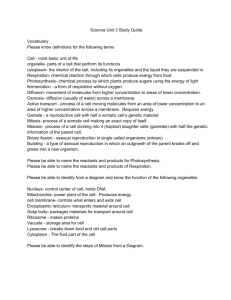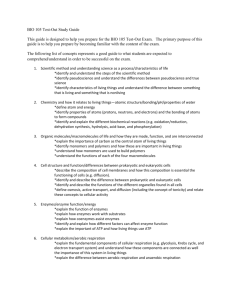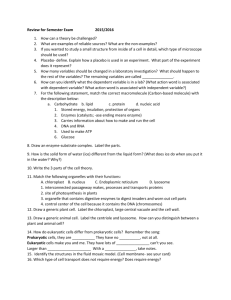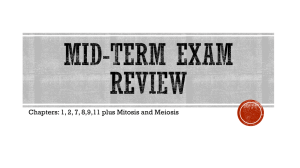HONORS BIOLOGY MIDTERM REVIEW
advertisement
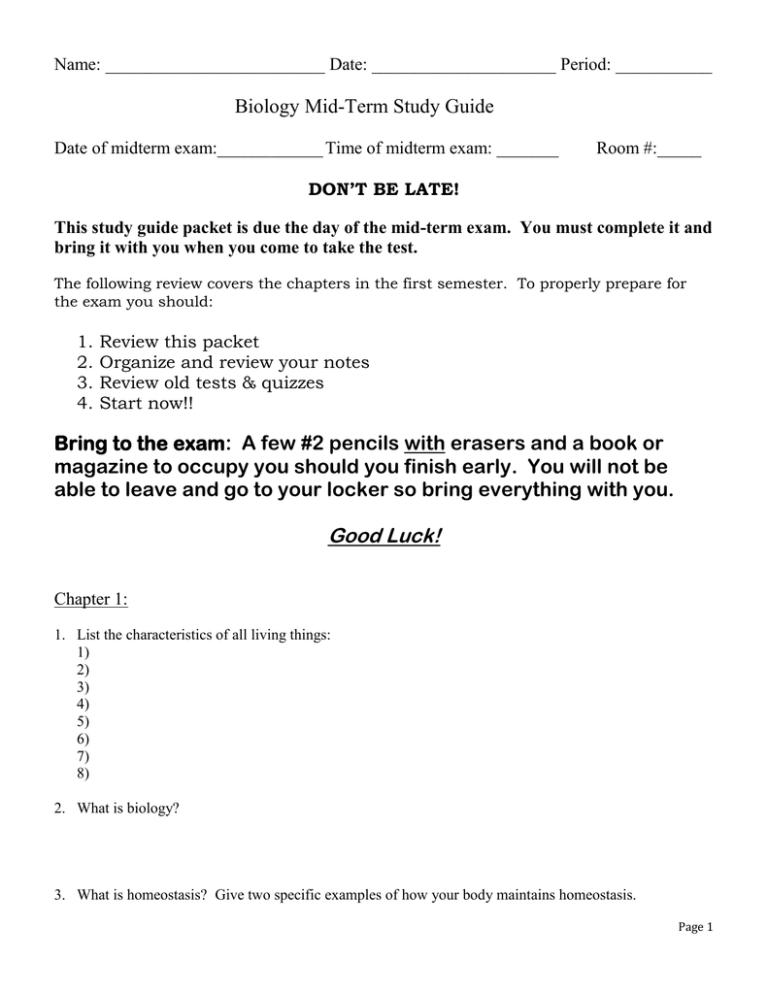
Name: _________________________ Date: _____________________ Period: ___________ Biology Mid-Term Study Guide Date of midterm exam:____________ Time of midterm exam: _______ Room #:_____ DON’T BE LATE! This study guide packet is due the day of the mid-term exam. You must complete it and bring it with you when you come to take the test. The following review covers the chapters in the first semester. To properly prepare for the exam you should: 1. 2. 3. 4. Review this packet Organize and review your notes Review old tests & quizzes Start now!! Bring to the exam: A few #2 pencils with erasers and a book or magazine to occupy you should you finish early. You will not be able to leave and go to your locker so bring everything with you. Good Luck! Chapter 1: 1. List the characteristics of all living things: 1) 2) 3) 4) 5) 6) 7) 8) 2. What is biology? 3. What is homeostasis? Give two specific examples of how your body maintains homeostasis. Page 1 Experimental Design 4. Read the experimental design and answer the questions: A group of students was trying to determine which type of soil would rose bushes grow the tallest in. They had five rose bushes that they planted in five different types of soil. The size of the pots were the same, they were watered the same amount and kept in the same light and temperature conditions. a. What was one possible hypothesis given the information above? b. What was the independent variable? c. What was the dependent variable? 5. Another group of students were trying to determine at what temperature a newly discovered fish will thrive. They set up four different aquariums and kept each at different temperatures. They put 100 fish in each tank and then counted how many were alive at the end of a week. a. What was one possible hypothesis given the information above? b. What was the independent variable? c. What was the dependent variable? d. What conditions need to be kept constant during the experiment? Microscopes 1. Label the diagram of the microscope. Page 2 What is the function of the following parts of the microscope? a. diaphragm: b. course adjustment: c. fine adjustment: d. stage clips: e. eyepiece f. revolving nosepiece Chapter 2: 1. Give the location and charges of the 3 subatomic particles in an atom. 2. What is an isotope? 3. What is the difference between the mass number of an element and its atomic number? Identify the mass number and the atomic number of zinc, calcium and argon. 4. Place the following in order from strongest to weakest: hydrogen bond, ionic bond, covalent bond. Explain how each of the bonds listed above form, what the differences are between them, and give an example for each type of bond listed. Page 3 5. What change is occurring in this figure? What type of bond will be formed between sodium and chloride? Why? 6. Fill in the table below: Element Symbol Protons Neutrons Hydrogen H 1 Helium He 2 Carbon C 6 Oxygen O 8 Neon Ne Aluminum Al Zinc Zn Electrons Atomic Number 1 Mass Number 4 6 8 10 10 13 20 27 30 30 65 Figure 2–4 7. What is the pH scale Draw the scale and show where acids and bases are located. 8. Use the chart to answer the questions below. pH Values of Some Common Substances Page 4 Substance pH Hydrochloric acid 1.0 Sulfuric acid 1.2 Tomatoes 4.2 Rainwater 6.2 Pure water 7.0 Sea water 8.5 Ammonium chloride 11.1 Sodium hydroxide 13.0 What is the strongest acid? Which is the weakest acid? Which is the strongest base? 9. What is a catalyst? 10. The graphs in the figure below show the same reaction: X + Y → XY, where X reacts with Y, producing XY. Explain why the two graphs differ. 11. What are the unique properties of water? Explain each property and be specific in regard to what it allows water to do. Page 5 12. Water is considered a polar molecule. Explain why. Draw a diagram to support your discussion. Chapter 3: 1. What is an organic compound? 2. Fill out the following table about organic compounds: Organic Compound Protein Monomer Examples Where is it found in the body Linkage between monomers Carbohydrate Lipid Nucleic Acid 3. Hydrolysis and dehydration synthesis are two processes that macromolecules use. Describe how each process works and what each process creates. 4. What is an enzyme? 5. What is the lock and key model of enzyme activity? Use the following terms in your description (active site, enzyme, products, substrate). Page 6 6. For each of the following statements, label as true or false _____ a. Enzymes are types of proteins _____ b. Enzymes slow down the rate of chemical reactions _____ c. Each enzyme is specific, it only works on one type of substance _____ d. Enzymes become denatured at high temperatures _____ e. Enzymes work best at a narrow pH range _____ f. Enzymes can not be reused. _____ g. Proteins are made of building blocks called amino acids _____ h. Proteins are made in the mitochondria of cells _____ i. Proteins make up our blood, hair, skin, heart, muscles, and bones 7. List three factors that can affect enzyme activity. Chapter 4: 1. What is a cell? 2. What are the three parts of the cell theory? 3. What is a prokaryotic cell? What is a eukaryotic cell? 4. What are three differences between a plant cell and an animal cell? 5. Explain the function of the Golgi apparatus, lysosome, and cytoskeleton. Page 7 6. Matching: Next to each organelle, write the letter of its function ______ mitochondria a. where proteins are made ______ cell membrane b. site of photosynthesis in plants, contains chlorophyll ______ cell wall c. transport system of the cell ______ endoplasmic reticulum d. provides support and protection for plant cell ______ nucleus e. storage area for the cells ______ vacuole f. powerhouse of the cell, makes energy ______ chloroplasts g. control center of the cell, contains the genetic information ______ ribosome i. is selectively permeable, controls what goes in and out of the cell 7. Label the diagrams of the cells below: Animal Cell: Plant Cell: A. A. B. B. C. C. D. D. E. E. F. F. G. H. I. Page 8 Chapter 5: 1. What does selectively permeable mean? 2. What types of organic molecules make up a cell membrane? 3. Describe how the chemistry of the cell membrane classifies it as having a “dual nature”. Draw a sketch of the membrane to support your discussion. 4. What is the function of the cell membrane? 5. What is the difference between simple diffusion and facilitated diffusion? 6. What does it mean when a cell has reached “equilibrium”? 7. What is osmosis? 8. Define the following terms: isotonic solution, hypotonic solution, and hypertonic solution. 9. What is active transport? 10. What type of organic molecule is needed for both facilitate diffusion and active transport? 11. What are the processes of endocytosis and exocytosis? Describe the steps in each process. 12. Define the following methods of transport: pinocytosis and phagocytosis. 13. What is the difference between diffusion and active transport? Page 9 Chapter 6 and 7: 1. Define photosynthesis. 2. What is the equation for photosynthesis? 3. What are the three stages of photosynthesis and where do each of them occur? 4. What type of organisms carry out photosynthesis? Differentiate between photoautotrophs and chemoautotrophs. 5. List the products of the light reactions and the products of the Calvin cycle. 6. What two molecules are recycled from the Calvin cycle back to the light reactions? 7. Trace the flow of electrons through Photosystem I and II in photosynthesis. 8. What is the most important energy harvesting molecule in organisms and what does it do? Draw a picture of the structure of this molecule below. 9. Does respiration require oxygen? 10. What are the two types of fermentation? Differentiate between their products. What do they both recycle? Page 10 11. What type of respiration yields more ATP? Why? 12. What is the equation for cellular respiration? 13. What are the three stages of cellular respiration and where does each stage occur? 14. Complete the chart below. Stage # of ATP made # of NADH # of FADH2 Location Glycolysis Oxidation of pyruvate Citric Acid Cycle Oxidative Phosphorylation Chapter 8: 1. What is the difference between a chromosome, a sister chromatid and homologous chromosomes? Draw a picture to support your discussion. 2. What is the difference between mitosis and cytokenesis? 3. What is a centromere? 4. List the five stages of the cell cycle. 5. Write the following stages in order: telophase, metaphase, interphase, prophase, anaphase 6. What are the 3 parts of interphase? What happens in each one? Page 11 Draw a picture next to the description on the left for each stage of mitosis INTERPHASE Longest stage Chromatin not chromosomes is visible Centrioles together PROPHASE Individual chromosomes are visible Centrioles move to opposite sides of the cell Spindle apparatus assembles Nucleolus and nuclear membrane disappear METAPHASE Sister chromatids line up along the equator of the cell ANAPHASE Sister chromatids are pull apart and move to opposite poles of the cell TELOPHASE The chromosomes are at opposite sides of the cell Nuclear membrane and nucleolus reappears 7. What is the difference between cytokenesis in animal cells and plant cells? 8. What does the term diploid mean? Give the diploid number for humans. 9. What does the term haploid mean? Give the haploid number for humans. 10. What are gametes? What are the two types of gametic cells? Page 12 11. Define the process of meiosis? What are three specific differences between mitosis and meiosis? 12. What is the process of crossing-over? What does it enable in all organisms that mitosis doesn’t? 13. List the stages of meiosis? 14. Complete the chart below. Mitosis Meiosis Type of cell to start Type of cells created (haploid/diploid?) Type of cells created (somatic/gametic) # of cells created Stages # of divisions Misc. Items: Define the following terms: Theory Hypothesis Prediction Be able to do the following: Be able to read and interpret a graph Be able to calculate the magnification of an object for a microscope Page 13
